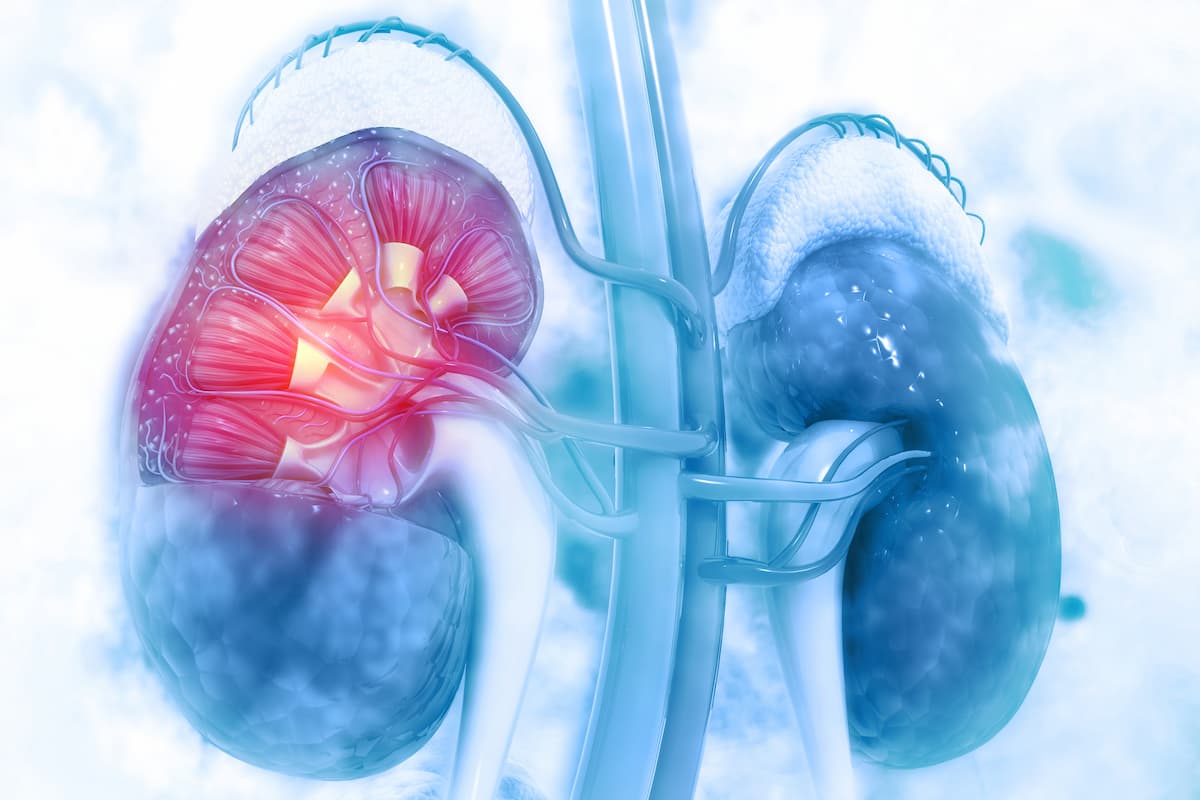Long-Term Follow-Up Data Support Lenvatinib Combo as SOC in Advanced RCC
Lenvatinib and pembrolizumab’s benefit proves to be long-lasting and significant in first-line advanced renal cell carcinoma, according to an expert from University of Bari 'A. Moro'.
Lenvatinib (Lenvima) plus pembrolizumab (Keytruda) continued to demonstrate improvements over sunitinib (Sutent) in patients with advanced renal cell carcinoma (RCC), according to data from an extended follow-up analysis of the phase 3 CLEAR study (NCT02811861).
“As a whole, the benefits of the lenvatinib plus pembrolizumab combination proved to be durable, statistically significant, and clinically meaningful,” according to an expert from University of Bari 'A. Moro.

The median follow-up for progression-free survival (PFS) was 27.8 months (interquartile range [IQR], 20.3-33.8) for patients receiving lenvatinib plus pembrolizumab and 19.4 months (IQR, 5.5-32.5) for those receiving sunitinib.
Median PFS was 23.3 months (95% CI, 20.8-27.7) vs 9.2 months (95% CI, 6.0-11.0) in each respective group (HR, 0.42; 95% CI, 0.34-0.52). The PFS rate in each respective group was 84.9% (95% CI, 80.6%-88.3%) vs 57.0% (95% CI, 51.1%-62.5%) at 6 months, 70.6% (95% CI, 65.3%-75.2%) vs 38.4% (95% CI, 32.4%-44.3%) at 12 months, 57.2% (95% CI, 51.5%-62.5%) vs 31.2% (95% CI, 25.4%-37.1%) at 18 months, and 48.6% (95% CI, 42.7%-54.3%) vs 22.6% (95% CI, 17.1%-28.5%) at 24 months.
PFS trended towards improvements with lenvatinib plus pembrolizumab vs sunitinib across all Memorial Sloan Kettering Cancer Center (MSKCC) and International Metastatic Renal Cell Carcinoma Database Consortium (IMDC) prognostic groups, although investigators noted that there was a small number of events.
PFS favored lenvatinib plus pembrolizumab over sunitinib in patients with MSKCC (HR, 0.18; 95% CI, 0.08-0.42) and IMDC (HR, 0.30; 95% CI, 0.14-0.62) poor-risk disease. Additionally, lenvatinib plus pembrolizumab improved PFS for patients with MSKCC (HR, 0.46; 95% CI, 0.35-0.60) and IMDC (HR, 0.41; 95% CI, 0.30-0.54) intermediate-risk and favorable-risk disease (MSKCC; HR, 0.43; 95% CI, 0.29-0.64; IMDC; HR, 0.47; 95% CI, 0.32-0.69).
“As a whole, the benefits of the lenvatinib plus pembrolizumab combination proved to be durable, statistically significant, and clinically meaningful,” senior author Camillo Porta, MD, stated in a written comment to CancerNetwork®.
Porta, chair of oncology in the Interdisciplinary Department of Medicine at University of Bari 'A. Moro and chief of the Division of Medical Oncology at Policlinico Consorziale di Bari, continued, “[Data support] the lenvatinib plus pembrolizumab combination as one of the present standards of care for the first-line treatment of patients with advanced or metastatic [RCC],” Porta wrote.
Investigators of the open-label, randomized, phase 3 CLEAR trial compared the efficacy of lenvatinib plus pembrolizumab with sunitinib monotherapy among patients with clear-cell advanced RCC at 200 treatment sites throughout 20 countries.
Patients were randomly assigned 1:1:1 to receive 20 mg of oral lenvatinib per day in 21-day cycles plus 200 mg of intravenous pembrolizumab every 21 days, and 18 mg of lenvatinib per day orally plus 5 mg of everolimus orally per day, or 50 mg of oral sunitinib per day using a 4 weeks on, 2 weeks off schedule.
Investigators did not include results for the lenvatinib plus everolimus cohort in the updated analysis.
The primary end point of the trial was PFS as assessed by independent imaging review according to RECIST v1.1 criteria. Key secondary end points included overall survival (OS), objective response rate (ORR), and safety.
Treatment-naïve patients ages 18 years and older who had not received any systemic anti-cancer therapy for histologically or cytologically confirmed advanced RCC with a clear cell component were eligible for enrollment. Additional inclusion criteria included having 1 or more measurable lesions per RECIST v1.1 guidelines; a Karnofsky performance status of at least 70; and adequate organ, renal, and bone marrow function.
Investigators randomly assigned a total of 1069 patients to study treatment, including 355 receiving lenvatinib plus pembrolizumab and 357 receiving sunitinib monotherapy. The median patient age was 62 years (IQR, 55-69) and 74% were male. In the lenvatinib plus pembrolizumab group and sunitinib group, respectively, most patients were White (74% vs 76%), had MSKCC intermediate-risk disease (64% vs 64%), and had received prior nephrectomy (74% vs 77%).
Median OS was not reached (95% CI, 41.5-not estimable [NE]) with lenvatinib plus pembrolizumab and not reached (95% CI, 38.4-NE) with sunitinib (HR, 0.72; 95% CI, 0.55-0.93). In each respective arm, OS was 91.4% (95% CI, 87.9%-93.9%) vs 80.2% (95% CI, 75.5%-84.1%) at 12 months, 86.9% (95% CI, 82.9%-90.1%) vs 73.8% (68.7%-78.2%) at 18 months, 80.2% (95% CI, 75.5%-84.1%) vs 69.7% (95% CI, 64.4%-74.3%) at 24 months, and 65.5% (95% CI, 59.4%-71.0%) vs 61.8% (95% CI, 55.8%-67.1%) at 36 months.
OS improved with lenvatinib plus pembrolizumab in patients with MSKCC (HR, 0.50; 95% CI, 0.25-1.02) and IMDC (HR, 0.39; 95% CI, 0.20-0.77) poor-risk disease. Additionally, investigators observed OS improvements with lenvatinib plus pembrolizumab over sunitinib in patients with MSKCC (HR, 0.71; 95% CI, 0.52-0.97) and IMDC (HR, 0.72; 95% CI, 0.52-1.00) intermediate-risk and favorable-risk disease (MSKCC: HR, 1.00; 95% CI, 0.51-1.96; IMDC: HR, 1.22; 95% CI, 0.66-2.26).
The ORR was 71.0% (95% CI, 66.3%-75.7%) with lenvatinib plus pembrolizumab vs 36.0% (95% CI, 31.2%-41.1%) with sunitinib. Additionally, the median duration of response was 26.0 months (95% CI, 12.5.2-41.4) vs 14.7 months (95% CI, 7.4-not estimable). The disease control rate was 90% (95% CI, 87.0%-93.2%) vs 74% (95% CI, 69.7%-78.8%) in each respective group.
Investigators conducted no new safety analyses for the CLEAR study, although Porta noted that “no unexpected or novel toxicities emerged with a prolonged follow-up.”
Reference
Choueiri TK, Eto M, Motzer R, et al. Lenvatinib plus pembrolizumab versus sunitinib as first-line treatment of patients with advanced renal cell carcinoma (CLEAR): extended follow-up from the phase 3, randomised, open-label study. Lancet Oncol. 2023;24(3):228-38. doi:10.1016/S1470-2045(23)00049-9
Newsletter
Stay up to date on recent advances in the multidisciplinary approach to cancer.







